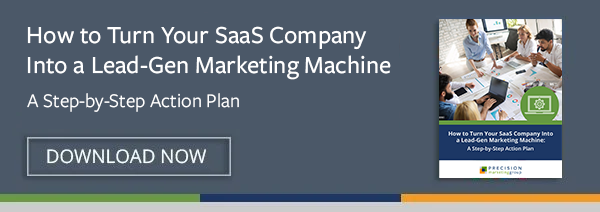The B2B Software as a Service (SaaS) industry is growing rapidly. With 7 out of every 10 companies using SaaS solutions, it comes to no surprise that SaaS providers are finding the space increasingly crowded and competitive.
In order for your company to gain market share, it’s essential that you have an effective marketing strategy in place. But in today’s environment, a successful B2B SaaS marketing strategy requires attention to many different factors—including customer targeting, messaging, and a comprehensive content strategy.
Many SaaS companies who develop the next best thing in their field want to hit the ground running and immediately begin promoting their solutions. To ensure you're truly ready and allocating time, budget and resources to the right channels, first address these preliminary marketing objectives, and you'll be well on your way to lauching a strategy that effectively converts website visitors into leads, and leads into customers:
Determine Your Target Audience and Create Buyer Personas
Understanding your target market and defining your prospective customer helps you properly define and market your SaaS as effectively as possible. You first need to figure out which segment; SMBs or Enterprise has the potential to deliver the most impact on your business goal. It’s also important to determine if will you be focusing on a specific niche market or industry, and who within the company will be your “ideal” customer.
From the C-Suite to the Director of IT to Line of Business Influencers—think HR, Marketing, Sales or Operations—there are several potential audiences involved with a SaaS solution decision.
Each specific audience will have their own pain points and areas of concern that need to be addressed. While a decision maker in the C-Suite is interested in how your solution will impact the company’s bottom line, the Director of Sales will be interested in how the new marketing automation software will generate and track SQLs.
As you narrow down your target audience, you will need to create a clear, concise, and in-depth overview of exactly who your ideal customer is: their demographics, motivations, where they get their information, and which social media channels they frequent. Creating what we refer to as buyer personas allows you to craft key messaging that resonates with your ideal customer. At the enterprise level, where many decisions are made by committees, you may have more than one target audience, meaning will need to create a buyer persona for each one.
Here are a few helpful resources we’ve already written to help you build your own buyer personas.
Develop a Solid Content Marketing Strategy
A strong content strategy can help software businesses build trust with potential buyers, drive more leads and help convert leads into sales. 94% of B2B buyers say they conduct some form of online research before purchasing a service or product, which means your potential customers are reaching out to you much later in the buying cycle. Creating a solid content marketing strategy can ensure that your providing engaging and quality content to potential SaaS buyers at each stage of the buyer’s journey.
Start by developing a compelling, unique value proposition statement.
Presenting a crisp and clear message that demonstrates your company’s value is critical in standing out in the crowded B2B SaaS space. You can do this by creating a compelling value proposition statement that communicates what makes your solution unique and better than your competitors’.
Effective SaaS positioning requires distinguishing your company from others not only by selling a great product, but by providing solutions to help your target audience achieve a desired outcome. Product features will only take you so far. It’s critical that you tap into the challenges your buyers are encountering on a regular basis, address them in your content and speak to how using your SaaS solution will make their lives easier. Once created, your value proposition will serve as the anchor point for all other marketing collateral and campaigns.
Then create content to showcase thought leadership and generate engagement.
In developing your content, be mindful that you are selling services, not just software. Again, sell the benefit and how your software solves the customer’s core business problems. Focus your solution based content on customer pain points and the end result they’re hoping to achieve after putting your software into action.
As you guide prospects down the path to the right solution for their problem, be sure to create content for each stage of the decision-making process: the Awareness, Consideration and Decision stages.
- Top-of-the-funnel awareness building content usually takes the form of a blog post, white paper, guide, checklist or infographic – something high level that’s not touting the advantages of your product but addresses a common industry concern. Consider modifying and leveraging technology information pieces to create blogs that will lead visitors to your website.
- Next, in the Consideration stage, move potential buyers further down your funnel with case studies that demonstrate ROI achieved from your software, a webinar that dives into more specific functionality, or videos that demo the user experience.
- Finally, for prospects who have reached the bottom of your funnel, whittling down their choices in the Decision stage, try serving up a chance to experience your product with a free trial or a free tier of the product. The goal is to create an experience that converts the lead into becoming a paying customer.
Remember to include distribution in your content marketing strategy. Your most engaging content can go largely unnoticed if you distribute it via the wrong channel. Once again, look at your targeted buyer personas, and consider where they hang out; digital or traditional, LinkedIn or Facebook, YouTube or Twitter. Perhaps consider some of the newer content outlets, such as Medium or Quora, to capture the attention of prospects, as well as to position your solution as cutting edge.
Establishing sound marketing objectives is key for any SaaS company. Start by looking at these areas to make sure you’re not overlooking any important components of your marketing strategy.











